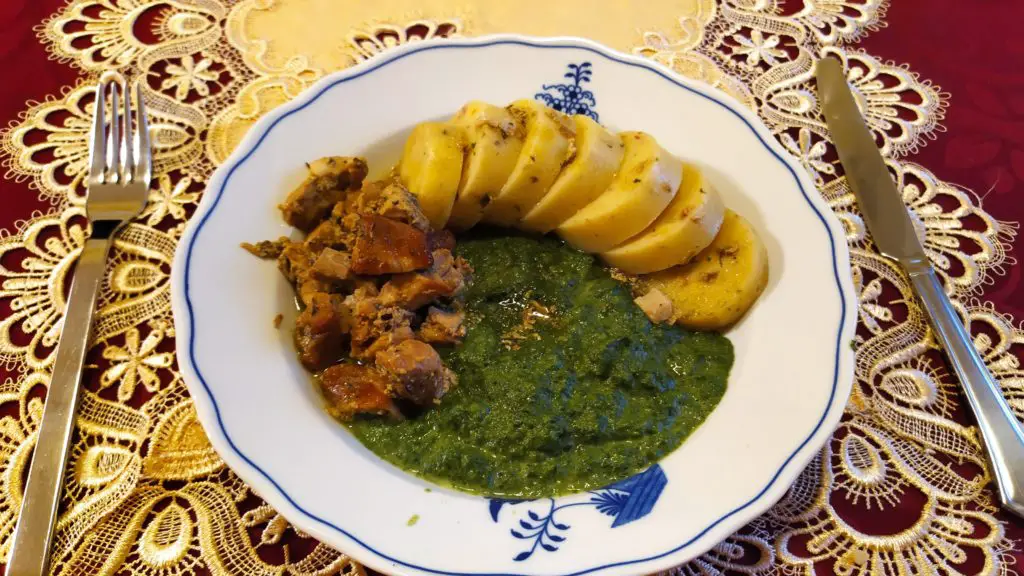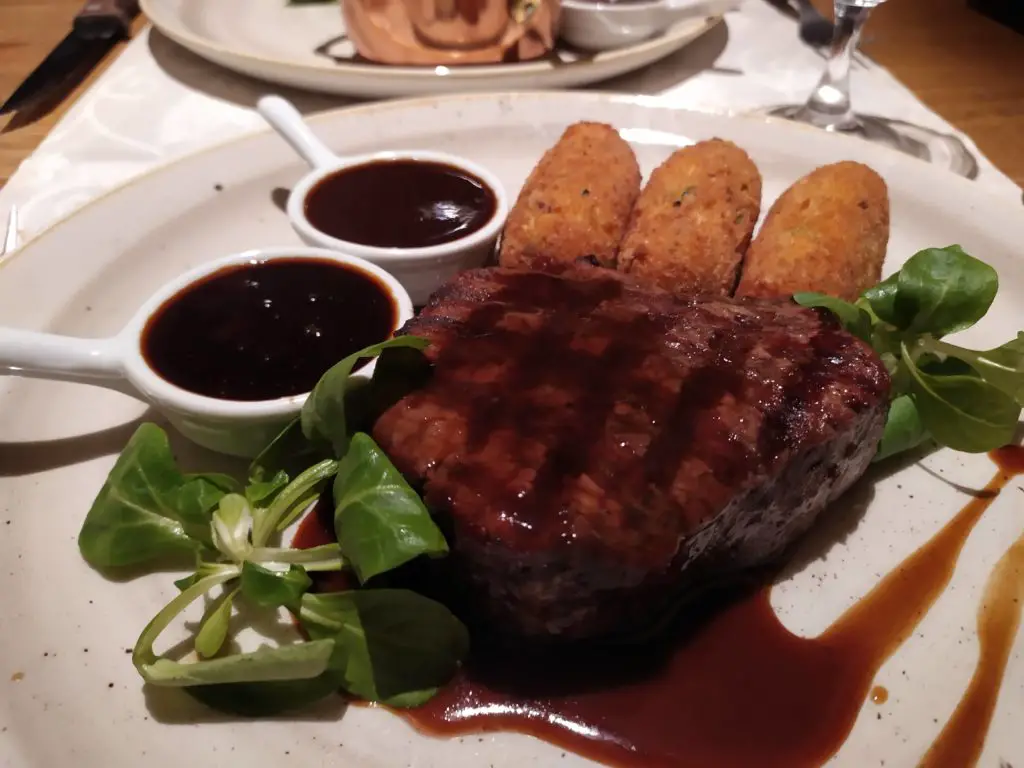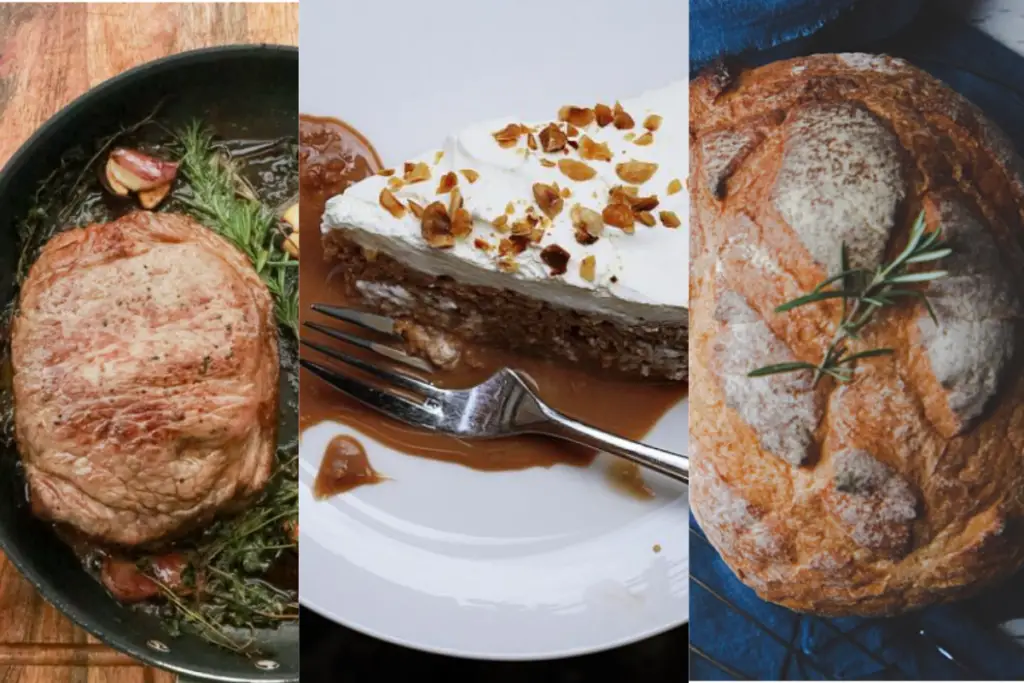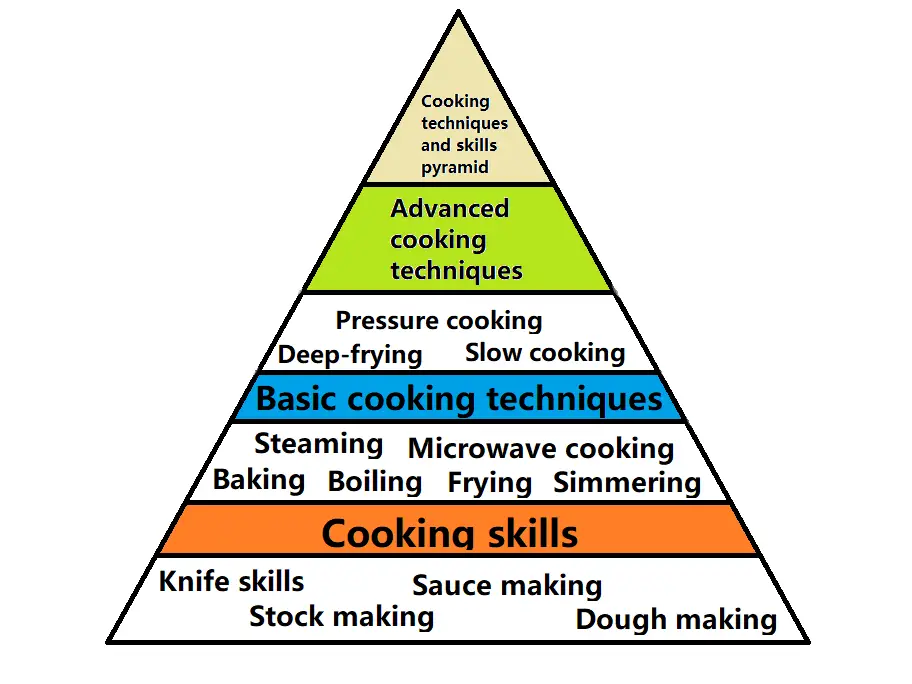Welcome to the article that will end all your questions and guide you on the beautiful journey through the home cooking world.
Even though you don’t have to know everything about cooking, you should have a basic understanding of the most popular and helpful cooking techniques and skills.
On this page, you will find the list of cooking techniques and skills that I believe are essential for every home cook of any level. It doesn’t matter what appliances you have at your disposal, if you have your favorite knife, or if there is a fully stocked fridge or not. What is important is your knowledge and skill. With those, anything is possible.
To gain knowledge, you have to read and learn.
To gain skill, you have to practice what you have read and learned.
This is because your ability will be limited by your knowledge and skill, no matter how much you love cooking. You cannot strive to be a competent cook or a chef just by watching a TV show.
There are many things that you can learn only by doing them. As this is the case, I will do my best to describe to you in detail how to execute them. Then You will have to come along and do them yourself. Repeat them many times to understand them fully and gain muscle memory.
Cooking is love. It is an expression of life and joy. And when you put everything you know and can into every single of your dishes, the results will show it.
In the beginning, your dishes might not be the prettiest ones out there, but if you make sure that they taste great, everything else will be forgotten. In the end, platting is something that can be easily taught. Cooking great food, on the other hand, is way more challenging.

As you learn and understand all ins and out of cooking. You will end up evolving from the picture above to the one below.

Before we jump in, I would like to clarify one thing.
The list below is not the most comprehensive list of cooking techniques and skills that exist.
I only mention the ones that I believe are important for every home cook to know and understand. If you are looking for a list of every single one known to humanity, check out Wikipedia.
What is the difference between home cooking and professional cooking?
Home cooking is done by an individual who cooks for a family or some other group. Home cooking generally takes place in private kitchens. Home cooks use their own ingredients, cooking methods, and home cooking appliances.
Professionals cooks are trained chefs with expertise in preparing food. Professional cooks can cook at restaurants, hotels, or (increasingly) gourmet food trucks specializing in catering to a particular cuisine.
Those are the most obvious differences.
But I believe that it is better to say that the main differences are experiences and preparation.
I am sure that you have seen many cooking shows on TV or the internet. Everything looks friendly, glamorous, and straightforward. Every professional cook has a fridge full of fresh ingredients that are prepared in an ideal way. Ten different stocks, loads of demi-glace to the heart’s content, and some foie gras.
Of course, it is made for shooting, but if you scout any PROs’ kitchen and fridge at any time, you will find similar things. Everything is prepared. Everything has its perfect and ideal place. Everything is easily reachable. Everything is clean. Professional chefs are taught to cook with one hand and clean with another. It is easier to cook in a clean environment.
Home cooks tend to incline towards organized chaos in the kitchen. This is partially due to inexperience and partly due to the lack of space. Professional cooks work in large kitchens, often with a staff of chefs who prepare the dishes. Home cooks often do it all themselves, whether they cook for a family or a group of friends.
Professional cooking is about doing it right the first time. Experienced cooks are responsible for every single aspect of what they cook. Every single dish must be nearly perfect in appearance, taste, and aroma.
Home cooking is about letting things happen. Some of these things can be intimidating, but when done right, they are fantastic and rewarding. Home cooks use shortcuts to save time and energy, but that can be problematic.
Soups, for example, are a great way to transform essential ingredients into something extraordinary. But making soup can be challenging at times.
Classic recipes call for beef and chicken stock, but home cooks often substitute them with premade stock to save time. Soups made with homemade stock can be wonderful, but they need to be seasoned correctly for each ingredient. You also should put some time and love into them.
If you are a home cook with inspiration to become a pro one day, don’t cheat. EVER. Learn how to do things properly. If you know that, you only need time and multiple tries to make it perfect in a short time frame. Cheating and substituting will get you nowhere.
So now, without further ado, let’s dive into my list of the most helpful cooking techniques and skills that I believe you’ll need.
Cooking techniques
The art of cooking has been around for many years. Cooking techniques are a lot of fun, giving us the ability to express ourselves in the cooking world.
In general, you can say that every technique is a different amount and type of heat and time. The main goal of all cooking techniques is to separate, mix and/or combine different ingredients.
To get the best results, you have to use the proper technique for the right recipe.
It also boils (pun intended) down to your culinary creativity, feelings, mood, knowledge, and skill. You can use different techniques to produce the same food.
I do separate my list into two main categories.
The first basic cooking techniques do not need any unique tool or appliance.
The second, advanced cooking techniques do require you to either have a specific cooking appliance or a more profound knowledge and cooking skill to execute them without it.
Let’s take a look at each category of the cooking techniques on my list.
Basic cooking techniques
I am putting everything I believe you need to have as a baseline in cooking into the category of basic cooking methods.
Anything else that you will cook in the future will be built upon these basics.
As soon as you know about baking, boiling, frying, simmering, steaming, and using a microwave, you will be able to tackle anything else.
Now without further ado, let’s take a closer look at each of the basic cooking methods you should know.

Baking
Baking is probably one of the most popular types of cooking technique. It’s an age-old process that involves baking raw ingredients in an oven, or several other hot environments, at a specified temperature.
If you are interested in understanding the whole baking and all of its ins and outs, check out my more in-depth article about it here.
It may seem easy to bake bread or cake with just some flour and water together for 30 minutes, but it can take much more than that to produce an excellent baked good. So before you try baking something, make sure you have a general understanding of how baking works.
For example, some recipes call for mixing the dry ingredients (flour, sugar, salt, baking powder, etc.) and wet ingredients (eggs, milk, mascarpone, flavoring, etc.) separately and combine them slowly later.
Other recipes will call for mixing all the ingredients simultaneously and letting the mixture rest for a while to gain volume.
Another caveat is that baking is closer to alchemy than cooking. It requires precise amounts and timings.
It may not sound like fun, but as soon as you get the hang of the basics, you can alter the recipes slightly to fit your needs more. Even before that, when you keep the recipe to the letter, you have a free hand to modify the look of your baked creation.
You can add whatever color, frosting, fruit, chocolate, fondant, nuts, small cookies, and anything else that you like. All these go great with cakes, pies, tarts, quiches, pastries, and many more.
Of course, you don’t have to bake only sweet things. You can go for salty ones too. Home-made bread is always great – my father-in-law makes ones to die for – and believe me, there is high-level alchemy behind them. Pastry, in general, is a great example, as you can have it filled with meat as well as strawberry jam or anything else you like.
This is a summary of baking as a whole. If you are more interested in the topic, check out my whole category designated to baking here.
Frying
Frying is a cooking technique in which food is cooked, or partially cooked, in hot fat or oil.
It can be done manually (in a pan) or with an electric fryer. The manner of frying could also involve the addition of foods that are typically boiled or steamed to create a specific texture or taste.
Frying is a modern technique that can be done with many different foods, from vegetables to meat. Most of the time, it’s done to give food a crispier texture, but there are other reasons as well.
For example, frying can be done to give the food a golden crust. It can be done to seal the food to maintain its flavor and moisture longer, or it can be done as a last-minute finish to heat it to sear.
When frying, there are a few essential things you have to consider.
First of all, you have to heat the fat or oil to a high enough temperature – just heating it a bit will not give you an optimal result.
Second of all, you have to control the temperature for an extended period. If you don’t, you will end up burning the fat or oil, which can result in charcoaling the food or producing an unpalatable taste.
Frying has a lot of its own sub-techniques, as quick research can show you. But in a nutshell, it’s pretty easy once you get the hang of it.
If you want to get a deeper understanding of frying, check out my detailed article here.
Simmering
Simmering is cooking food in liquid at a temperature that is below boiling point.
This technique often uses the liquids obtained from cooking vegetables or meat. The idea behind it is not to let the liquid evaporate and ruin the taste of the dish.
There are many recipes in which simmering is used. For instance, you can use this method to cook vegetables, and while it does take more time, it produces a better result.
Another famous example is slow cooking, which I consider a slightly more advanced technique. But, again, you need a particular appliance to execute it well or enough knowledge to work around not having one.
When simmered, food has to be exposed to the liquid at a low enough temperature, but not too low. Usually, simmering refers to temperature under boiling point.
The results depend on what you are cooking. Generally speaking, simmering is the best way to cook vegetables and give them a better texture and taste. Great examples of foods that benefit most from simmering are soups and stews.
Other notable examples are oatmeal, porridge, grains, vegetables, and eggs.
Check out my more detailed article on simmering here.
Microwave cooking
Microwave cooking is a relatively new technique, but it’s one of the most popular and widely used ones in the world.
I am aware that this might seem like an overstretching, but hear me out here.
I am including microwave cooking in the list mainly because of its widespread usage in all countries worldwide. Almost every household on the planet has a microwave. It is a multifunctional appliance that is easy to learn but hard to master.
If you don’t believe me remember the last time you were reheating the previous night’s pizza. Was crust dried out and impossible to chew? Well, that is most likely because you didn’t splash it with a bit of water. This would turn the water into vapor, which the pizza crust would soak up.
See? One little tip can change the whole dish. Thus easy to learn but hard to master.
Another critical point is that it is accessible to all cooks and chefs, no matter their knowledge and skills.
I agree that the microwave should not be used as a standard cooking technique. Still, when your resources are limited, it can be a saving grace in a tricky spot.
In short, microwaving is a method of cooking food and beverages by exposing them to electromagnetic radiation in an oven called a microwave.
This technique is pretty simple, but the fact that it’s so quick makes it easy to mess up.
The result is either delicious or dry and rubbery. A typical microwave has two settings to pay attention to power level and heated time.
If you have found the tip about pizza crust and water intriguing, check out this link for more details about microwave cooking.

Advanced cooking techniques
I would love to create a category named slightly more advanced but still basic cooking techniques. Still, it would sound weird, so let’s stick to the refined cooking techniques definition.
This category involves cooking techniques that I still believe are essential for every home cook to know. But might require you to use either a specific cooking appliance or knowledge and skill to pull off correctly.
Deep frying
Deep frying is very popular. This is because deep-fried food has a crispy texture. It also tends to capture the original flavor of the ingredients better.
It might not be seen as the most healthy way to cook food, but it remains a popular choice. The main reason for this is that deep-frying doesn’t require much prep on your side. Also, there are some states like Louisiana where deep-fried food is considered a national treasure.
Deep frying is not only about fried food. It can be used for many other dishes: pancakes, fish and chips, donuts, chicken wings, and many more.
It involves submerging the food you’re cooking in oil and heating it to a high temperature to cook it through well. When done correctly, this produces a crisp, flavorful, and juicy result.
Deep-frying can be done in a pot on a stove, but the best results are achieved in specialized deep-fryers.
Take a look at this article for more details on deep frying.
Pressure cooking
Pressure cooking is a cooking method that involves cooking in a pressurized container to speed up the process.
The goal is to build up steam inside of the container. This steam then surrounds the food and transfers heat to it, making it cook through more quickly.
Pressure cooking is mainly favored by people who don’t have as much time as they would like to cook. Single moms, students, business people, and anyone else who cannot spend a lot of time in the kitchen. Or by those who want to cook something delicious but are not that interested in it.
There is a lot of things that can be said about pressure cooking. How do they work? Can pressure cookers explode? Are they worth your money? All these answers and more can be found here.
Slow cooking
Slow cooking is one of my favorite techniques. I am a big fan of all things slow-cooked.
Slow cooking involves cooking food at a low temperature for a more extended period, usually, 4+ hours, which helps it retain nutrients, tenderness, and flavor.
It is a slightly advanced version of simmering, which I have mentioned above. Of course, slow cooking works best when done in slow cookers, but you can figure out a workaround in a tight spot.
It’s perfect for vegetables and meat, which can be tough and chewy when cooked with other methods. Plus, it doesn’t require much effort on your part to cook or clean up after, so it’s an excellent option for those who don’t want much fuss but want a fantastic meal. Or the opportunity to spend time with their loved ones while the tremendous dish is being prepared.
Slow cooking is simple in general, but there are tips and tricks that everyone should know. If you are interested in more, check out my article about it here.
Cooking skills
For those of us who love to cook, cooking skills are a must. These are the secrets to getting your food just right and perfecting your recipes. However, there’s something for everyone, from basic knife skills to complex techniques that will take you years to master.
Cooking skills are often confused with essential recipes. Since cooking skills involve kitchen skills, you should not be intimidated by the word. Don’t shy away from cooking because you don’t know where to start. Start with a knife in the kitchen and learn about knives. Learn the basics and work your way up to more complicated ones.
As I said, let’s take a look at the base of all cooking skills – knife skills.
Knife skills
Knife skills are the basis of every other cooking skill. Without them, you cannot effectively act in your kitchen and produce delicious food. If you aren’t familiar with basic knife skills, I would like to help you out here.
I hope these basics will help you, and I guarantee that you will be able to cook delicious food after learning them. You won’t have to worry about your knives any longer.
The blade is the most critical part of a knife. It would be best if you kept it sharp. Dull blades are a pain to use and are unreliable, so if you don’t have the time to sharpen your knives yourself, get a sharpening tool.
It is crucial to have at least one sharp knife in your kitchen, as it will be the main work instrument at the beginning.
There are a lot of things I would love to tell you to know about knives and knife skills, but they are far beyond the scope of this summary. Things like the knife is an extension of yourself, and whatever you do in the kitchen with your knife is going to be only as good as your blade is.
If you want to know more, check out the article on knife skills here.
Sauce making
Sauce making is a surprisingly simple process, but one that can be very time-consuming. They are easy to learn but hard to nail down every single time. So a lot of practice is involved when learning how to execute them properly.
It involves cooking with wine, salt, garlic, and herbs to create sauces that you can use in your recipes in the future. They go bad very slowly and can be stored in the fridge for up to six months or frozen for up to two years, so they are another staple pantry item.
Along with being straightforward and time-consuming, it is also incredibly versatile – from adding creaminess to tomato sauce to giving a quick tarragon flavor boost on eggs or potatoes.
Essentially any recipe can benefit from sauce making if you have the proper ingredient ratio and know where certain flavors go best within the sauce’s moods.
Every home cook should know at least the five basic sauces, as this knowledge gives you a wide variety and options to create a change in the sauce as needed.
My deep dive into the whole sauce-making can be found here.
Dough making
Last but not least the dough making.
The dough is a basic yet complex and powerful element to cooking. It can be made with various ingredients, from flour and water to milk, eggs, butter, and sugar.
Making the dough is not difficult once you get the hang of it. There’s a lot to learn about dough making, though – from what flours are suitable for what dishes to five different ways of mixing your dough.
In terms of favoritism, I think it is a 50:50 amongst home cooks. Some hate it. Some love it. Some think it is a necessary evil that one should know.
In my home cooking journey, I have gone through a myriad of recipes, and to be honest, dough making is now stuck in my brain forever. I use it too often, but primarily for its simplicity, yet I need to combine the right and exact ingredients. Combine them in the correct order and work the dough in a specific way.
It is easy to overwork the dough or not combine the ingredients correctly. The result may not show immediately, but the final dish will not be as you have imagined it. A cookie might not rise, a cake might not be firm, and bread can be too rigid and thick.
On the one hand, you might think that it is not worth the hassle, but I believe that it is better to learn a little about dough making, as excellent dough is a base layer for your creations.
A lot more details about dough making can be found here.
Final word
I have created this article as a meaningful crossroad for everyone interested in starting a journey as a home cook. For everyone who wants to know more. For everyone who is looking to smile on the faces of their family and friends.
This article is the first essential step towards becoming a better cook. And I will always recommend everyone who wants to know more about cooking – try to make some recipes, explore new ingredients and never stop learning.
Cooking is mainly about knowledge and skills, but you will never achieve the best results without passion and love for food.
If you are interested in expanding your knowledge about cookware materials take a read here. It covers the most used cookware materials available today and everything you need to know about them.
Because food made with passion, love, knowledge, and skill always tastes better 🙂
This article was about basic cooking skills and techniques for beginner home cooks. If you would like to know more about it, you can check out my articles right here on HomeCookingTech.com.
Are there any techniques that you would like to see included in this article? Did I miss some essential skills? Do you have any comments?
If so, please let me know in the comments below.






















2 responses to “EVERYTHING You Need to Know about Home Cooking”
[…] techniques and flavor retention tips, you can take your slow cooking to the next level and create delicious and healthy meals with […]
[…] it comes to making delicious home-cooked chips, preparation is key. Here are some tips for preparing your potatoes to ensure that your chips come […]